[PC-88, Koei]
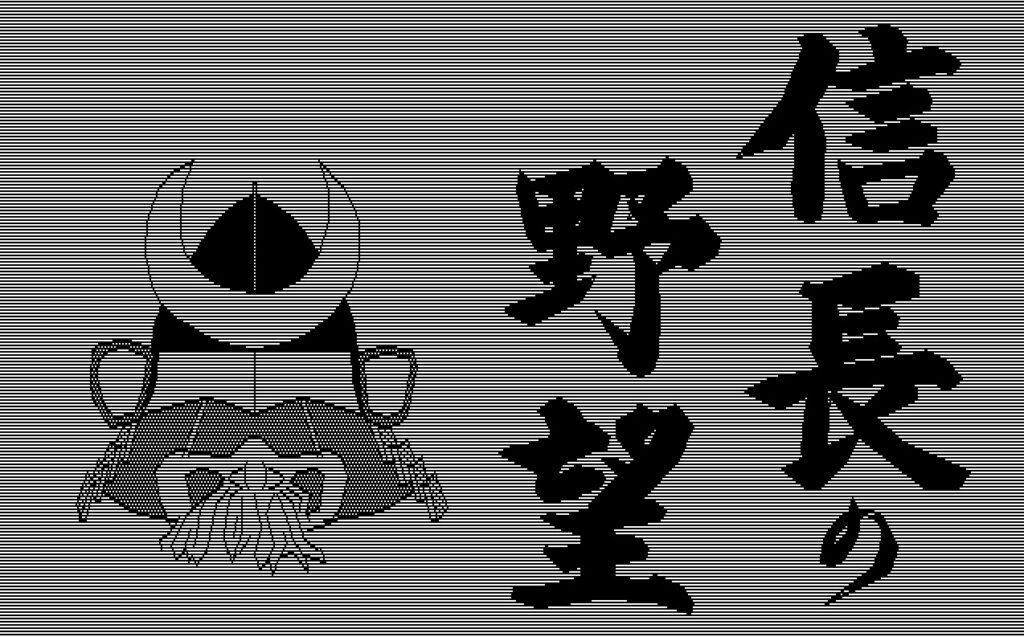
Why do you insist on calling this “Nobunaga’s Ambition”. I have only 54 in ambition. That’s almost my dump stat !
But, Oda-dono, we can’t call the game “Nobunaga’s IQ” or “Nobunaga’s Luck”!
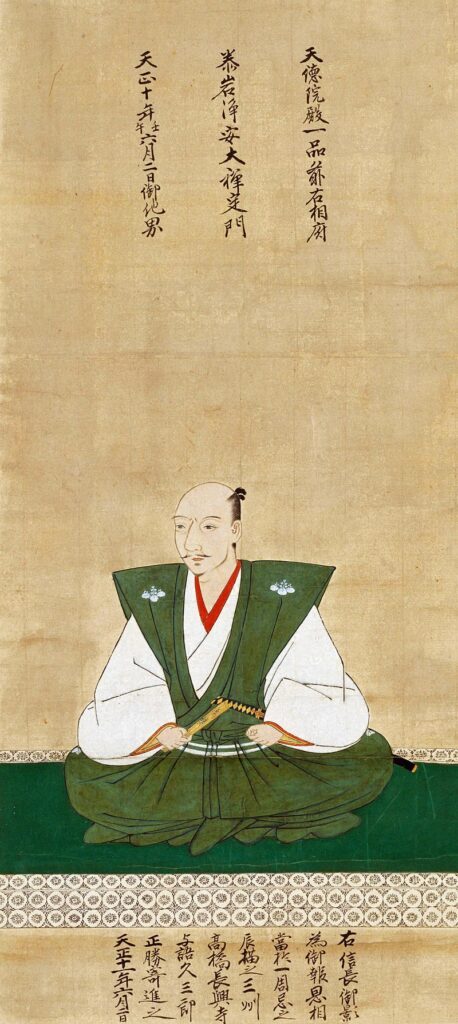
Nobunaga’s Ambition takes its name from Oda Nobunaga (1534-1582), one of the three Japanese “unifiers” in the Sengoku era. The game starts in 1560 and Nobunaga, then 26 years old, must occupy the 17 provinces of central Japan represented in the game. Nobunaga will be helped by the fact that Japanese politics in Nobunaga’s Ambition is a high-stake and brutal tontine: the 17 daimyos in the game don’t have successors, instead at their death all their provinces will be given to whoever killed them, or distributed to their neighbours if they die of old age at exactly 70.
The game starts with the player randomly generating Nobunaga’s stats :
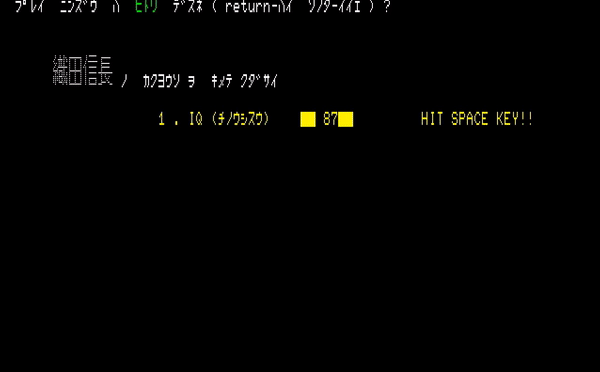
The five stats are IQ[Intelligence], Health, Ambition, Charisma and Luck. The stats go from 30 to 130 so I am below average: ugly, sickly, not that ambitious after all, though quite intelligent and luckier than average. I don’t understand the exact impact of the stats, but I know the game feels significantly easier with strong stats.
Before I go any further two disclaimers:
- When I was around 14-15, I realized the world was vast and that I would either know a few things about most of the world, or a lot of things about a few parts of the world. Already a nerd, I decided to go the latter route and mentally excluded huge chunks of the world from my area of interest. I stuck to that (with a few adjustments) up to now. Japan did not make the cut. The end result is that I have a pet name for every diadochi but did not know who was that Tokugawa fellow the first time I played Civilization. So, as I quite frankly navigate the period with Wikipedia, expect a lot of blunders in this article : people and clan names mixed up, provinces that are not where I believe they are or stuff I don’t even imagine. Feel free to correct me in the comments, or I am bound to make a fool of myself in every game about Japan that I will cover.
- The game was never translated from Japanese (the translated game known in Europe and North America as Nobunaga’s Ambition is actually the second opus of the series), so the opening of the game looks like this :
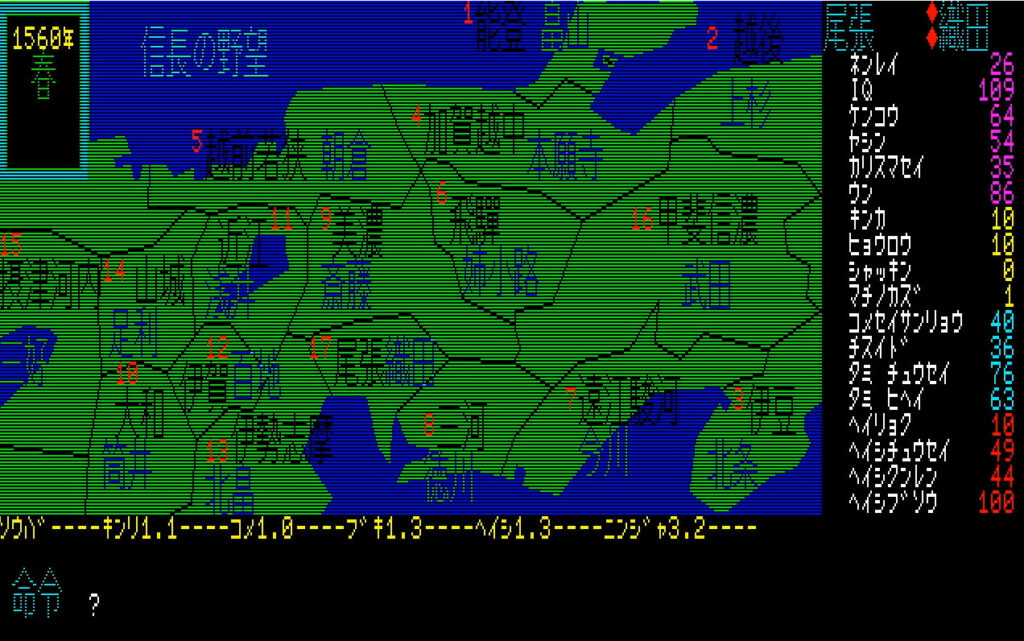
Commenter Helly helped me and translated the keywords in this menu, so here is the same menu translated (I used a contextual translation rather than a literal one) :
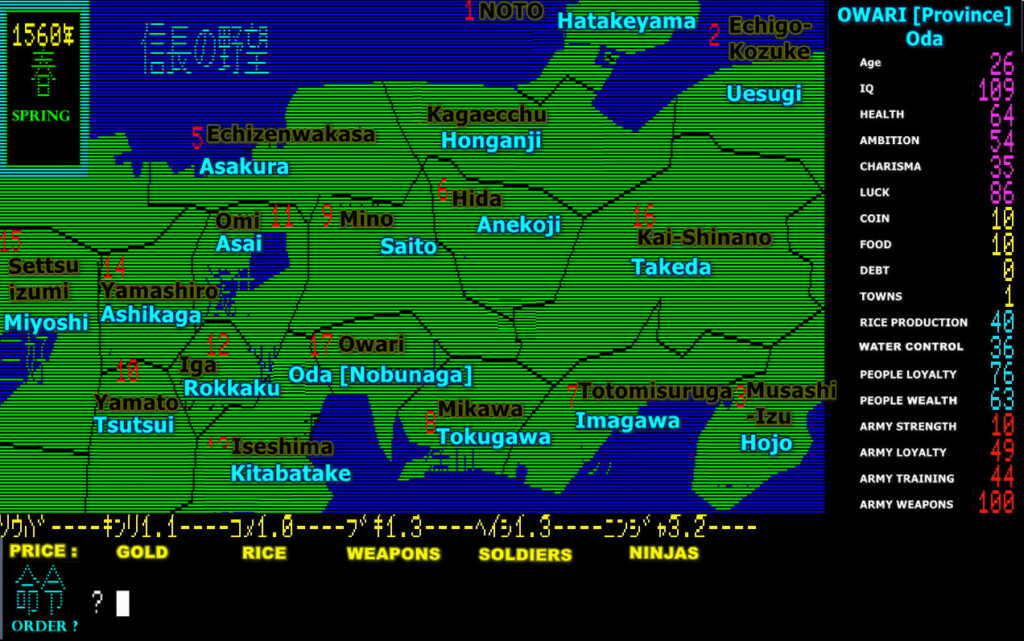
- On the right,
- the top 6 numbers are the stats of my leader (Oda Nobunaga),
- all the other values are province-specific (in this case : province #17 Owari), I will get to them later,
- The values in yellow at the bottom are the current price – they change a lot. A price of 1.1 in “gold” means that if I want to borrow one gold I will have to pay back 2.1 gold the following year,
- Each province has a name in black and a lord [daimyo] in turquoise. All the daimyos always start in the same province as the opening situation is I believe historical,
To help read the AAR, I will edit the screenshots to display the stats on the right every time, but I won’t translate the stats at the bottom (rarely useful) and the provinces (too time-consuming to do cleanly).
So, from that relatively humble start, will ugly Nobunaga be able to unify central Japan ?
Years 1560 – 1566 : Nobunagism in one province
In Nobunaga’s Ambition, except the Daimyo himself, there is no global resource. Everything is local. Daimyos of course can transfer resources from one province to another, but growth is exponential and the limit of development of a province is very high, so it is I believe better to focus on one province rather than spread out. My initial strategy was therefore to focus on Owari and ignore the rest of Japan.
Wealth in Nobunaga’s Ambition is basically the number of coins and food you have. Coins and rice are produced by respectively the “town value” and the rice production. But this is not all. The production can be further increased (multiplier effect) :
- For rice, if the value of the water control is high (it also protects against typhoons),
- For gold, if the wealth of the people is high,
- For both, if the loyalty of the people is high,
Finally, you can increase or decrease taxes, but since it impacts loyalty it is easy to find yourself on the wrong side of the Laffer Curve – I will not touch it.
Each turn represents a season, during which the player can give one order by province among a list of 14 orders :
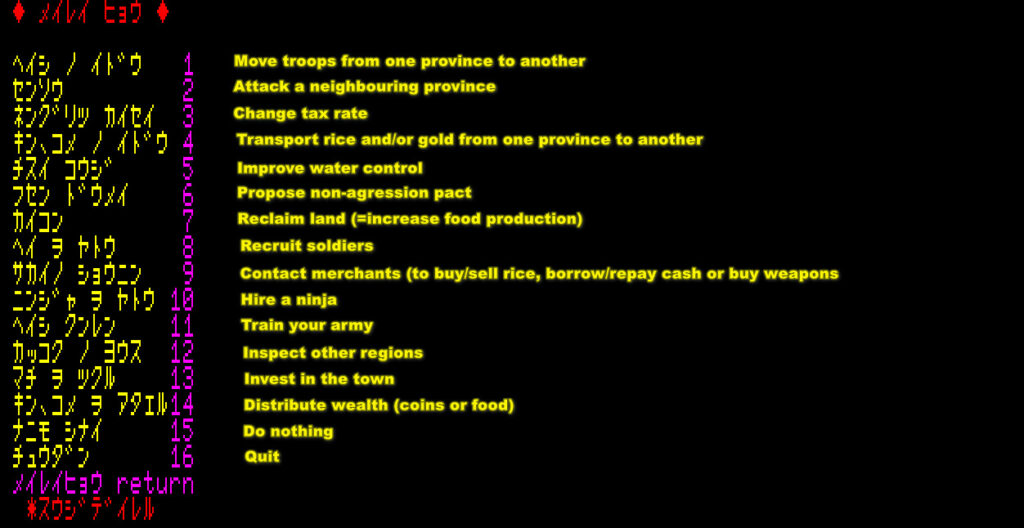
Gold is the most valuable resource for economy growth : reclaiming land, improving water control and investing in the town all require gold. All my coins are immediately allocated to growing the town, but to make sure to have a very powerful start the rice is also distributed to peasants, making them happy and productive.
It is fall already, which is the season when taxes and food rent are collected and soldiers paid. I receive a lot of cash, but unfortunately, I have not produced enough food to feed all my soldiers, and their number [“Army Strength”, in thousand ] moves from 10 000 to 7 000. Worse, with 0 food, I am horribly vulnerable: during battles soldiers consume food, and if they don’t have any, the battle is lost. To prevent my neighbours from being able to conquer me without combat I buy a pittance of food (2 units) from merchants – enough for 7 000 men to hold 8 battle turns. It should be enough, I checked and my neighbours don’t have enough food to attack with a large force.
Early 1561, the first daimyo is eliminated : Uesugi Kenshin attacks his old rival Takeda Shingen and destroys him – looks like the Battle of Kawanakajima was decisive this time. That would not have happened if I had been in charge of Takeda’s forces. Things really heat up later in the year, and I recruit 10 000 men.
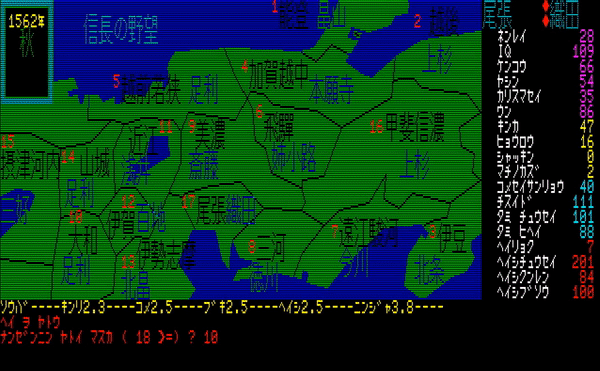
This garrison keeps me safe for the time being, and to sum up several years of gameplay in one line, I keep investing gold into my town, distributing excess food to my people and my soldiers. Everyone’s loyalty is through the roof, and in Fall 1566 my taxes generate an absolutely ludicrous amount of money and quite a lot of food, too.
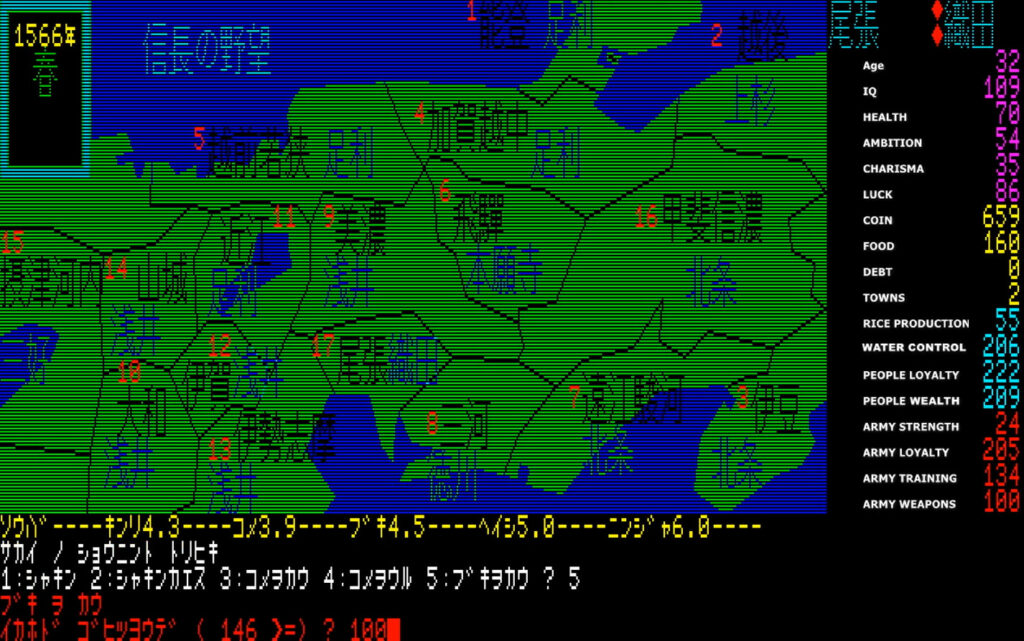
My province of Owari is a powerhouse. It is time to look at what my neighbours are doing.
Years 1566 – 1567 The destruction of the Asai clan
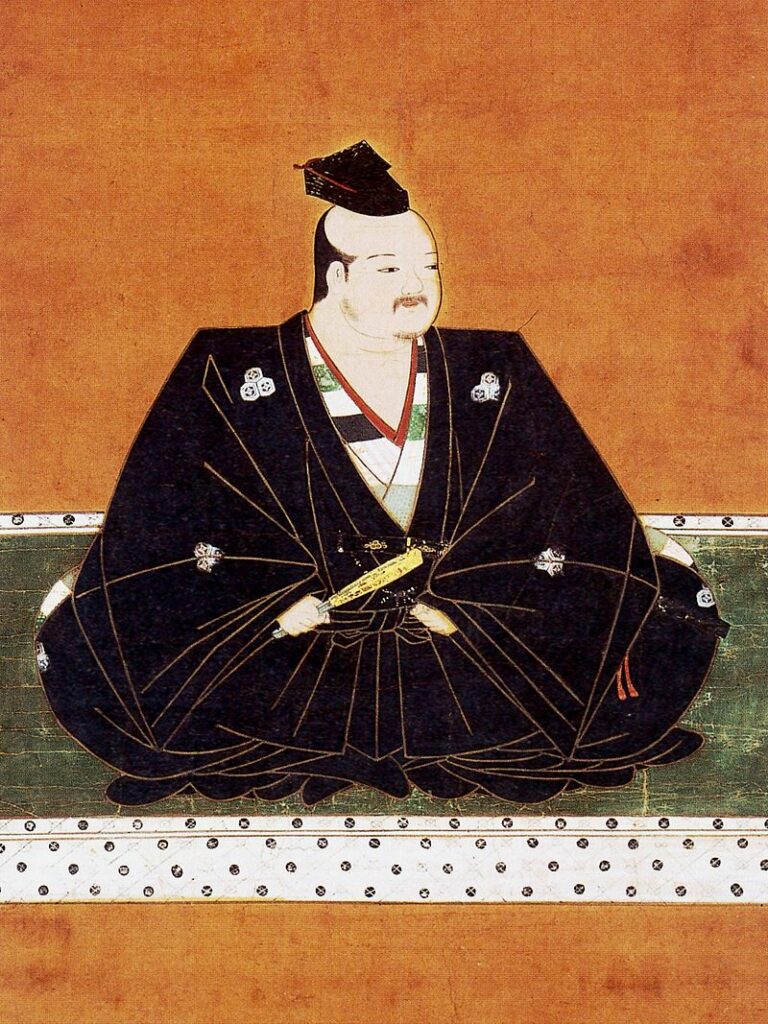
By 1566, the map simplified a lot, with only 8 clans left. The two most powerful daimyos with 5 provinces each are Ashikaga from the Yoshiaki clan, currently controlling most of the Northern seaboard, and, almost fully surrounding me, Nagamasa from the Asai clan.

My attention focuses on Iseshima (province #13, on my left), under the control of Asai Nagamasa. Taking the province will not create me any new neighbours.
Nagamasa has 28 000 men against 24 000 in my province, but I am so wealthy I can recruit 30 000 additional men, so now I have quite the advantage. But I need to keep a strong garrison in my home province, so I don’t want to allocate more than 20 000 men to the attack. And I am confident that it will be enough, because in Nobunaga’s Ambition quantity alone does not win battles. Victory or defeat also depends on quality, and namely :
- the stats of the Daimyo, but not much I can do there
- the loyalty of the army (easily increased by distributing gold or food),
- the training of the army : increasing training by 10 takes one turn but is otherwise free, so there is no reason to choose “skip a turn”,
- how many “weapons” the men have,
Except for the personal stats, I am qualitatively way above Nagamasa. That’s good, but I acquire an extra, unbeatable edge. In Nobunaga’s Ambition, most values are soft capped at around 200. The exceptions are the resources, the army strength and, for some reason, the number of weapons which is not capped at all. With the cartload of cash I have, I buy weapons, a lot of weapons, an insane number of weapons : 1000 units. Every one of my soldiers has a full set of knives and two tanegashimas, plus extras to give to the kids.
My army ready, my 20 000 men invade Iseshima :
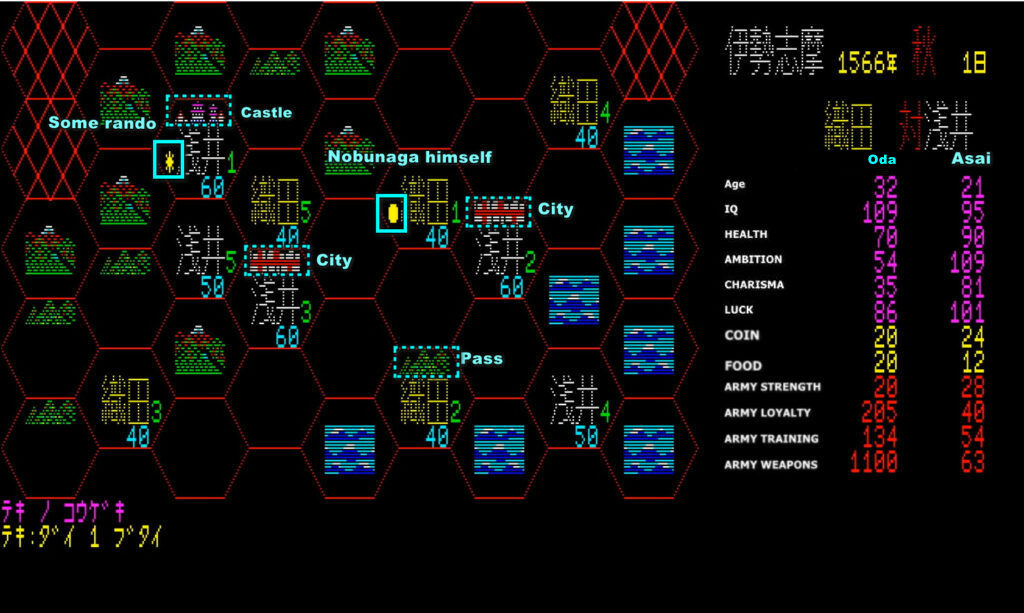
Battles occur on a tactical map (each province has its own map which never changes) with each side divided in 5 units, whose strength depends on how many men are fighting. With 20 000 men, my forces are represented by 5 units of 4000 men, whereas the Asai clan can count on 3 units of 6000 men and 2 units of 5000 men.
The first unit of each side includes the leader. In my case, Nobunaga joined the battle – he doubles the strength of his unit. Nagamasa on the other hand is not there, so there is no special bonus for the Asai clan.
The first unit of the defending clan also spawns in the castle, a strong defensive position, with the rest of the units spawning in cities (if any) or randomly out in the field. The units of the attacking clan start in totally random positions.
A battle lasts until :
- One of the leaders is killed (its “unit #1” is defeated),
- One of the sides runs out of food, which is an automatic defeat. The attacker can bring 1 in food by “army strength”, and taking the maximum possibly for the army allows to hold 30 turns maximum,
- One of the sides decides to retreat, which will save the leader,
The loser of the battle, whatever the cause, gives all its men, coins and food to the winner, so battles are always high-stakes.
I would like to tell you I used some very clever tactics to defeat a foe superior in number, but that’s not what happened. My army is so superior in training, morale and especially equipment that I wipe out the enemy without any losses. My army swells as the survivors of the Asai clan join my ranks.

Unfortunately for the Asai clan, the loss of the Iseshima province is not the only bad news for the season. In Nobunaga’s Ambition, provinces are called in random order to play their turns, and the Iseshima province is called after my native Owari province : I can play again. I move North and attack the Asai clan again in the Iga province (#12) :

This time, I cannot count on the superior quality of my force. In Nobunaga’s Ambition, army’s training and equipment are strictly local, so the force which conquered Iseshima brought back its weapons to Owari after their victory, and decided to forget everything about their training to become as poorly trained as the army they just defeated. The only value somehow retained is army loyalty, and even then not fully.
Still, this time I have 27 000 men against 14 000, so the lower quality of my force is compensated by sheer numbers. I win again.
That’s all for me, but the Asai clan receives yet more bad news as the Ashikaga clan strikes from the North, seizing the Mino and the Yamashiro province. The Asai clan seizes back the defenceless Iseshima in early 1567, and in late 1567 I come back. This time, Asai Nagamasa is there !
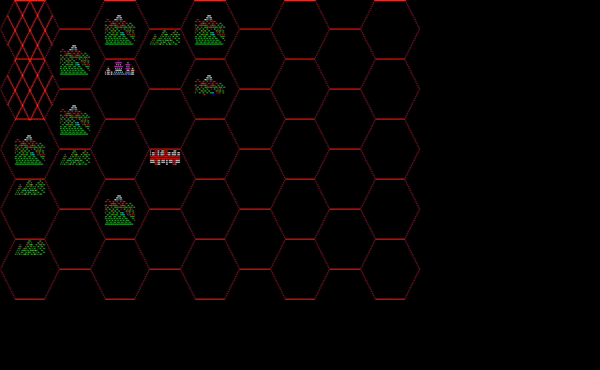
The battle is trivial because Iseshima is a death trap. Asai Nagamasa has to fight with the terrible local army training and equipment, whereas what I bring is adequate. Additionally, the AI is stupid : instead of waiting defensively in its castle or cities for me to run out of food, Nagamasa’s units attack my own units, losing those engagements. Nagamasa is killed during one of those sorties, and his clan collapses. I take control of what’s left of its domain.
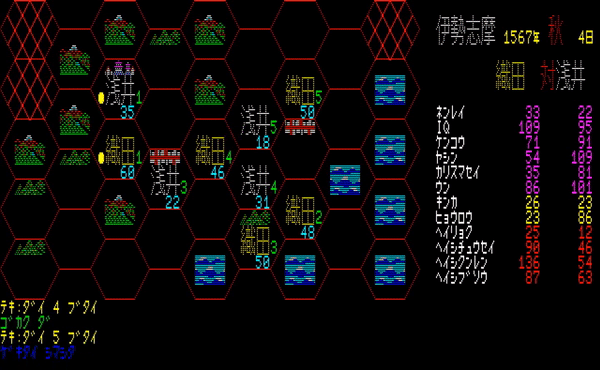
Years 1567 – 1569 The anti-Ashikaga co-belligerency
While I was focusing on the Asai clan, the map consolidated further as the weak Uesugi, Takeda and Hoeganji clans were destroyed. As 1567 ends, there are only 4 clans left.

- The Ashikaga clan in the North is the most powerful clan and its leader Yoshiaki has some seriously buffed-up stats, including 130 in ambition. It is strong economically, but even more so militarily, with in particular 100 000 well-trained men in the Kagaecchu province (#4). At least that army is far away from me.
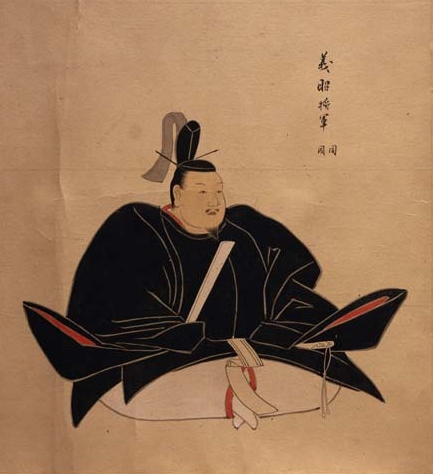
- The Hojo clan controls the East. Its armies are well-trained but relatively small for now. It is on the other hand economically stronger than the Ashikaga clan. Its leader Ujiyasu is aged and mediocre (not as much as me, but still), totally lacking ambition.
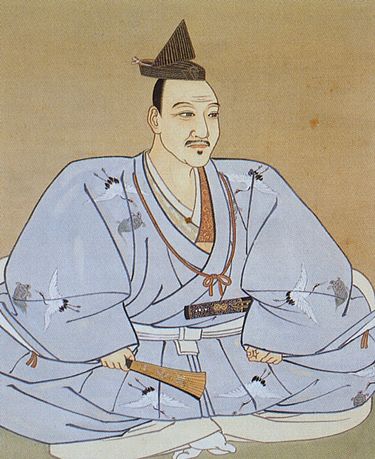
Also, his hat is a sailboat for some reason.
- The Miyoshi clan controls only one province with a good economy and a powerful and motivated force of 85 000 men. A chronic lack of excess food prevented thus far the clan to expand. Its leader Nagayoshi has high ambition but very low IQ and luck, which maybe explains why the crops keep failing.
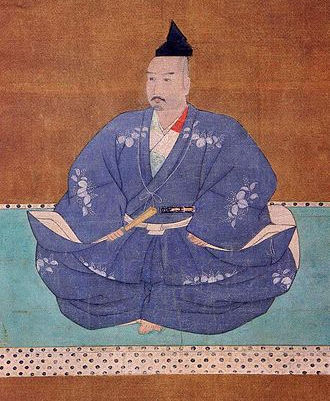
- As for me, I can only count on my home province, the other provinces I took from the Aisa clan are lagging behind economically and unable to support a large army.
I want to focus on only one opponent at a time and I decide to “negotiate” with the Hojo clan. “Negotiating” is maybe an exaggeration ; in Nobunaga’s Ambition the only diplomatic option is the non-aggression pact, as it is managed in a pretty artificial way. For 10 gold, you can sign a non-aggression pact with any daimyo (he does not have a say), under which there is, according to the manual, 70% of chance (-10% every turn) that he does not attack you when he would have wanted to.
Signing a non-aggression pact with the Hojo clan, I allocate all my effort against the Ashikaga clan, and mechanically so does Hojo Ujiyasu by lack of a better target. My part of the war effort is not initially going too well though. Not wanting to take risks on the attack, I send almost all my armies every time, allowing Ashikaga to take back the provinces I came from, and then more. We mostly swap provinces for a year.
But things change when the Hojo clan takes the Echizenwakasa province [#5] !
The Ashikaga clan’s domain is split in two !
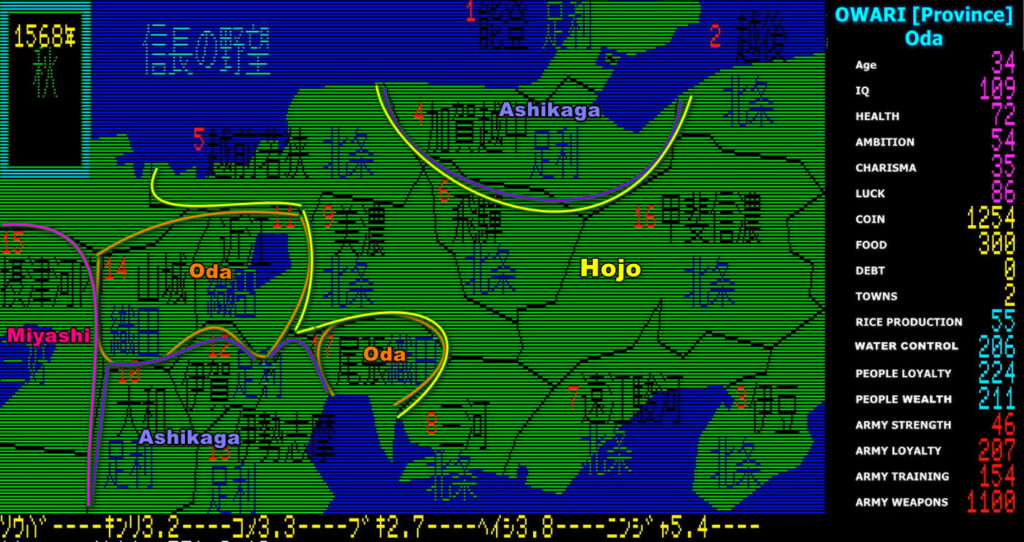
I have never met Yoshiaki Ashikaga in battle, and from that I deduce he is in one of the two provinces surrounded by the Hojo clan. Based on that intel, I am confident I don’t have to bring overwhelming forces every time, and so I start to garrison properly behind my main force. I merge Nobunaga’s force with reinforcements from Owari in Iseshima, and I spend the rest of 1568 mopping up the Ashikaganese from my side of the map.
Meanwhile, the Miyashi clan has one more disastrous harvest, and this time it has no food at all. No food means auto-defeat at the end of the first round of the battle. I send my force to seize the province.
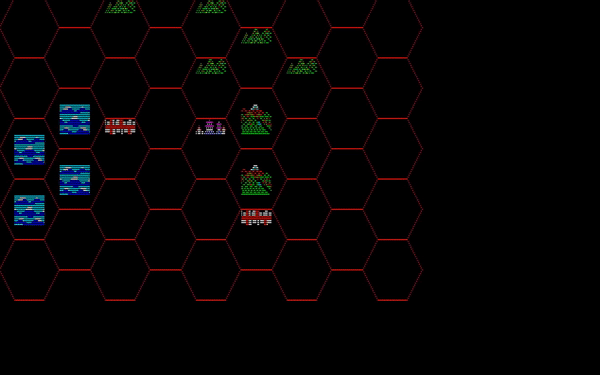
By early 1569, the map has changed a lot :
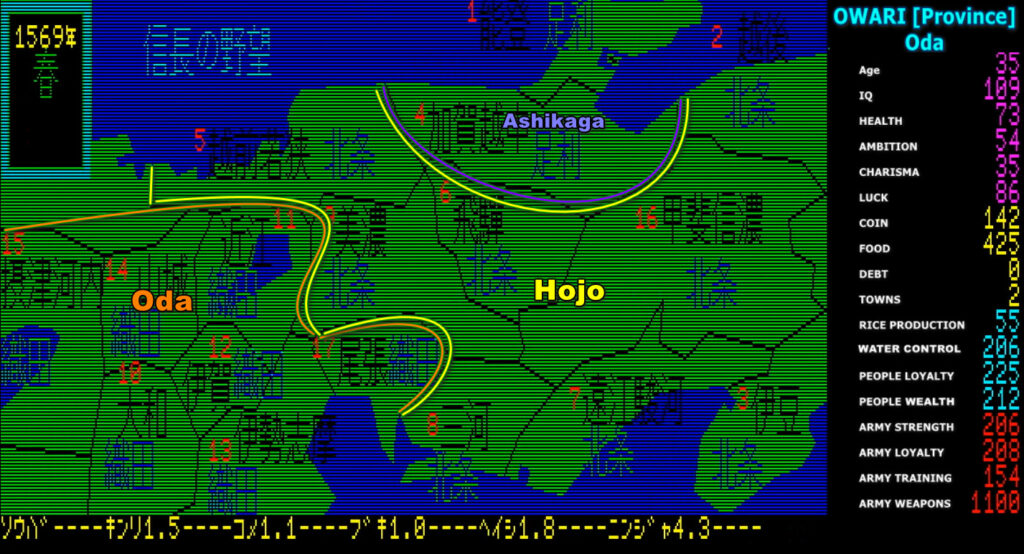
Year 1569 – The end
At the beginning of 1569, the Ashikaga clan is not on my border anymore – it is time to destroy the clan Hojo, which is larger but militarily weaker than mine. My strategy is simple : first snatch those provinces that won’t add the Ashikaga clan as a neighbour, and then, well, we’ll see.
As I attack the Mikaya province (#8), I immediately move to the “we’ll see” part of the plan :

In the battle of the Mikaya province, 100 000 men from the Oda clan, with the best weapons money can buy, and then even more weapons, meet 35 000 trained but dispirited men from the Hojo clan led by Hojo Ujiyasu himself.
Ujiyasu could have fled immediately, but he did not. He is killed in battle, and my clan inherits its holding.
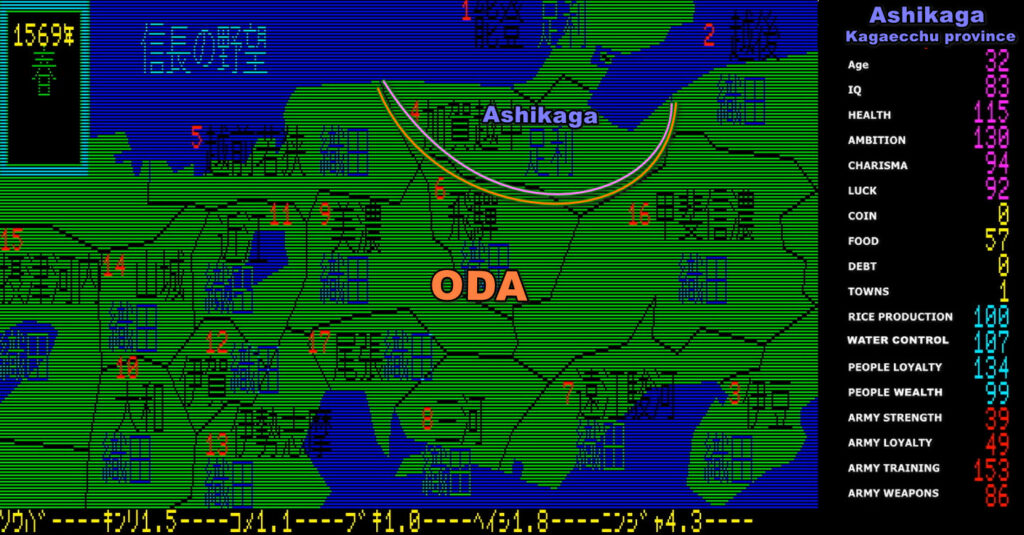
How the zataku has turned, Yoshiaki !
I don’t see how I can lose and my forces move toward what’s left of the Ashikaga clan
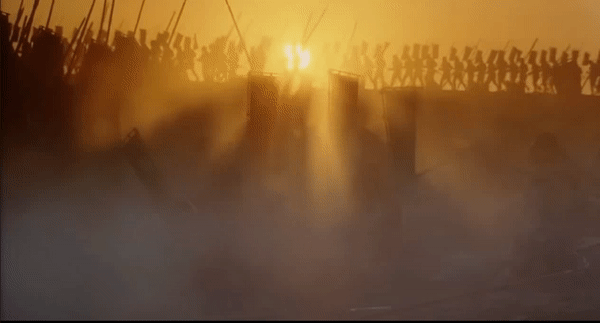
But Ashikaga Yoshiaki disagrees, and attacks aggressively ! The troops I inherited from the Hojo clan are out of position, and the Ashikaga clan takes the 2 Western provinces (#2 and #16). Flying from victory to victory, Yoshiaki then attacks the central province of Hida (#6), poorly garrisoned.
The last battle of the war is not exactly the Grand Finale you were waiting for. 7 000 men from the Ashikaga clan, led by Yoshiaki, attack 11 000 men from the Oda clan, with Nobunaga absent.

The quality of the soldiers of both sides is equal, and while the Ashikaga clan has fewer men it presumably expects the leadership of Yoshiaki to make the difference.
For a moment, it looks like Yoshiaki might pull it off indeed as his guards destroy 2 of Nobunaga’s units without losses and reach the castle.

But the 3 000 Oda men in the castle do not sortie and let Yoshiaki assault the fortress. And indeed, unable to bring reinforcements from the North, Yoshiaki’s men exhaust themselves attacking the fortress.

And before he can retreat, the garrison counter-attacks and kills him !
Nobunaga’s ambition has been realized. Japan – or at least the middle of it – has been reunified under his fist, in less than 10 years.
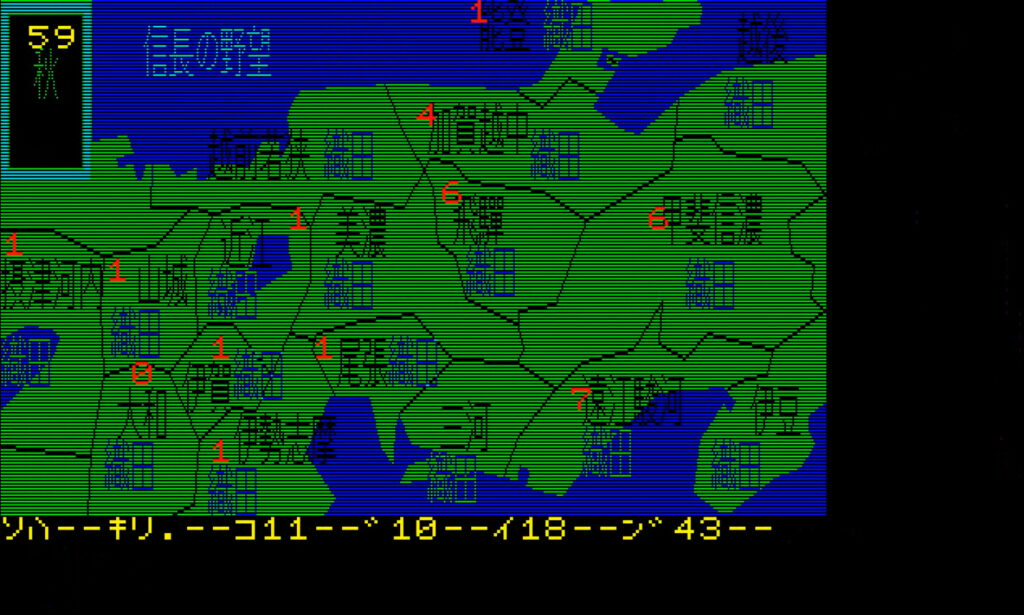
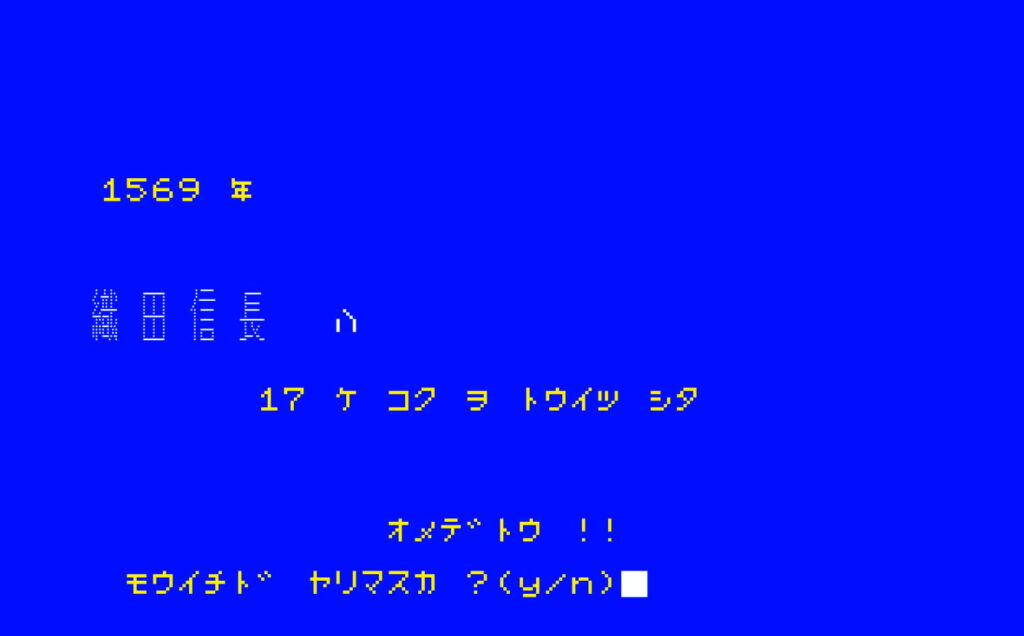
Rating & Review

Nobunaga’s Ambition by Kou Shibusawa (Yoichi Erikawa)
First release : March 1983 ,
Tested on : PC-88 emulator, Steam
Total time tested : 8 hours
Average duration of a campaign: 2 hours
Complexity: Average (2/5)
Would recommend to a modern player : No
Would recommend to a designer : No
Final Rating: Totally obsolete
Ranking at the time of review : 36/60
When reading this review, keep in mind I had to use a lot of Google Translate – there is very limited information on early Koei in English – so take it with a pinch of salt
After the unexpected success of Kawanakajima no Kassen, Yoichi Erikawa – still managing his dye business – decided to publish more games with the objective of generating revenue. Those games ranged from “Adult” (famously Night Life in 1982, officially “an aid for the sex life of couples“) to RPG (“The Dragon and the Princess“) but also a couple of totally forgotten 1982 wargames in BASIC I only found out about while doing my research for Nobunaga’s Ambition : Combat, and Battle of Normandy. All those games with the (possible) exception of The Dragon and The Princess were coded by Yoichi Erikawa alone.
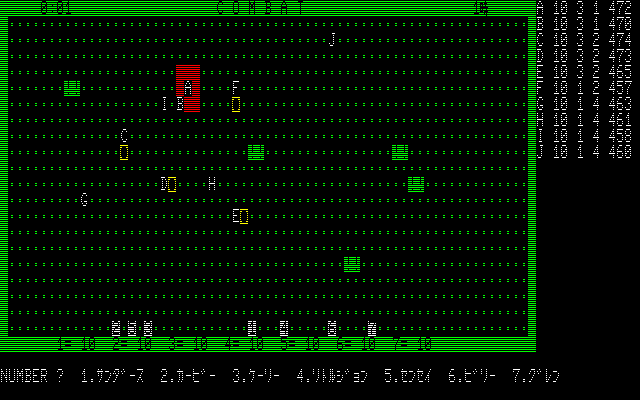
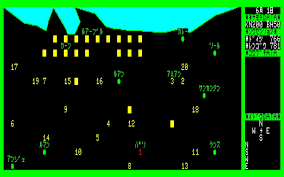
Nobunaga’s Ambition was initially a game like the others, a sequel to Kawanakajima no Kassen with presumably only one of Oda Nobunaga’s famous battles. But Yoichi Erikawa wanted to give more importance to management (from his own business experience) and show more than just the warring class for better immersion in the Sengoku era. Extremely happy with the end result of what could have been a terrible feature creep, he credited himself for the first time under his artist name Kou Shibusawa. Unfortunately, I could not find any description of how the game was initially distributed.
Nobunaga’s Ambition had a lot of sequels, but it also received 3 versions in the last 40 years :
- The first 1983 edition, and its many, many ports
- Nobunaga’s Ambition Returns (1995), which follows exactly the same ruleset and uses exactly the same map, but with UI, graphics, sound and music improvements,
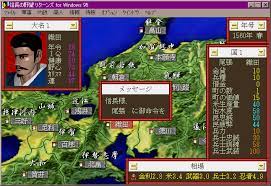
- A Steam reedition in 2016, which is exactly like the 1983 edition with the exception of some bug fixes and conversion from a katakana-only writing system to something more natural to Japanese (with kanjis),
I trained on the last one, but the AAR has been done on the first version, on which the review will be based.
A. Immersion
I am very mixed on immersion. The weird ruleset (soldiers not carrying their training or their experience, how you can cheaply distribute gold to 5 000 men, making them super loyal, and then recruit 50 000 men who will be just as loyal as the 5 000 first ones, winner-takes-all in battle, …) is a serious immersion breaker. On the other hand, playing the game in Japanese for a game based on Japanese history was immersive, but I don’t think it should count for obvious reasons.
Rating : Very poor
B. UI, Clarity of Rules and Outcome
The game is very easy to play with, the controls are intuitive and the game has a high tolerance for mistakes. On the other hand, it lacks predictability. After hours of play, I am still unable to predict production, consumption or really the exact impact of any territorial improvement due to the combination of many factors to take into account and very high randomness. For instance, I still don’t know whether it is soldier loyalty, soldier training or soldier weapons which has the most impact on combat efficiency. This is also particularly frustrating as a bad harvest can pretty much kill you by making you unable to defend.
Rating : Very poor
C. Systems
Nobunaga’s Ambition is only the second game so far (after Pursuit of the Graf Spee) to offer both a strategic and a tactical layer, with the former impacting the latter. It should give the game a lot of points, but unfortunately, I don’t think it works – yet.
On the tactical layer, the problem is that there are no tactics after all : I know the result of probably 95% of the battles before they even start. The compounded impact of stats (loyalty, training and weapons) is so high that in most battles, one side cannot be harmed at all by the other. In those rare battles where both sides can harm the other on the field, the defensive bonus of the castle will be so high that the attacker will be unable to destroy the unit defending the castle (like in the final battle of my AAR). And if the sides are balancing in a way that the castle defenders can both deal damage and be damaged, then it means it is all the other defenders are useless plebs who will not be able to do anything against the attackers. The end result is that :
- in almost all my defensive battles, my strategy was to move my units #2 to #5 out of harm’s way so my opponent dies against my castle,
- in almost all my offensive battles, my strategy was to beeline toward enemy unit #1 in its castle and ignore the rest.
The weak AI does not help make those battles interesting.
This makes 50% of the game totally uninteresting, only leaving a lacklustre strategic layer. There is an optimal path to economical growth, so the only decision you will take is on how to allocate your one action : build up the economy, build up the army, sabotage your rivals’ economy with ninjas (an option I never used in my AAR) or attack. Later, a few more options relative to the transfer of troops or resources will have to be considered, and you will also have to take into account that strictly local training and weapons create a weird “hidden” map of the provinces (with those from which it is hard to attack and those that are good assault launching pads). Overall, there is strategy there, but it is dry, especially with the lack of real diplomatic options, and it does not carry the game.
Rating : Very poor
D. Scenario design and balancing
There is only one scenario, lovingly handcrafted. Each daimyo has “historical” stats, with Tokugawa the best by far (almost max possible stats) and Kitabatake the worst. Takeda and Uesugi are ex-aequo the second and third most skilled daimyos, lacking only in health and luck.
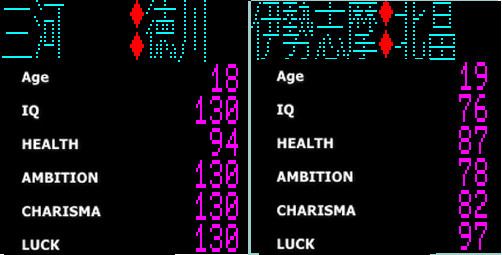
Not much to say about the scenario except it is not rich enough to be replayed.
I cannot judge the strategic AI, but the tactical AI is pathetic. On the tactical map, its routine is :
- If a target is in range, attack it,
- If no target is in range :
- If you are in the castle or a village, stay there,
- Else, move toward enemy unit #1
It is extremely easy to abuse, in particular by sitting next to the enemy castle so the enemy attacks without its defensive bonus rather than the other way around. I won too many battles I should have lost.
Rating : Very poor
E. Did I make interesting decisions ?
Rarely. The beginning of the game is mostly about optimizing economic growth. There are a few decisions to take after that, but I would not say the density of decisions is high.
F. Final Rating
Flawed and obsolete, but I am confident that it is a basis from which something great can be built – just a little balancing of the tactical battles would go a long way already.
I did not even attempt to check the Japanese contemporary reviews, but the game seems to have had tremendous success. It received many Japanese prizes and reached an unexpectedly wide audience, up to the point that according to Yoichi Erikawa a special version was made to be distributed in elementary schools. The game is sometimes credited as creating the Grand Strategy genre, and indeed I don’t see any earlier game which could make this claim, except possibly PLATO games like Empire (1972).
In any case, for Koei there was a before and an after Nobunaga’s Ambition. Some of Koei’s earlier games had beaten (fairly limited) expectations and had convinced the Erikawas to carry on making games, but the success of Nobunaga’s Ambition was something else : it was so huge that it enticed the Erikawas to move to a new office and allocate all their time on software development, instead of trying to have software development in addition to their dye-trading activity. Coincidentally, they soon stopped developing erotic games, with the last one published in 1985. Now a full-fledged software company, Koei immediately started publishing third-party games, but also carried on producing “historical” simulations, not only the 15 and counting Nobunaga’s Ambition games, but also their equivalents for China (Romance of the Three Kingdoms, 14 titles on PC and about as many on console) and various one-off titles (eg Rise of the Phoenix, Bandit Kings of Ancient China, Gemfire…). Development was iterative, with each version building up on the previous ones, typically the second opus of Nobunaga’s Ambition adds the choice of the starting daimyo, a stronger diplomatic layer and a larger map, plus of course 1986 graphics. There will be a lot more Koei on this blog, especially once I reach 1985.
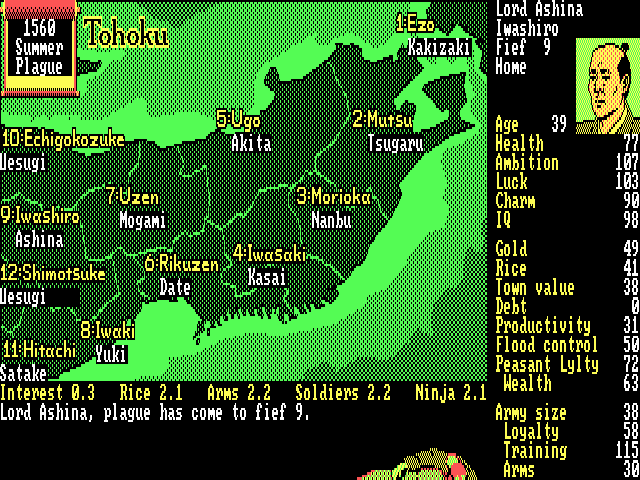
Speaking of Japanese games, playing untranslated games is difficult, and AARs for these are particularly time-consuming. Morito no Battle Field looks extremely interesting (it may be an ancestor of Advanced Wars) but I need the manual. Until then, I have to skip the game.
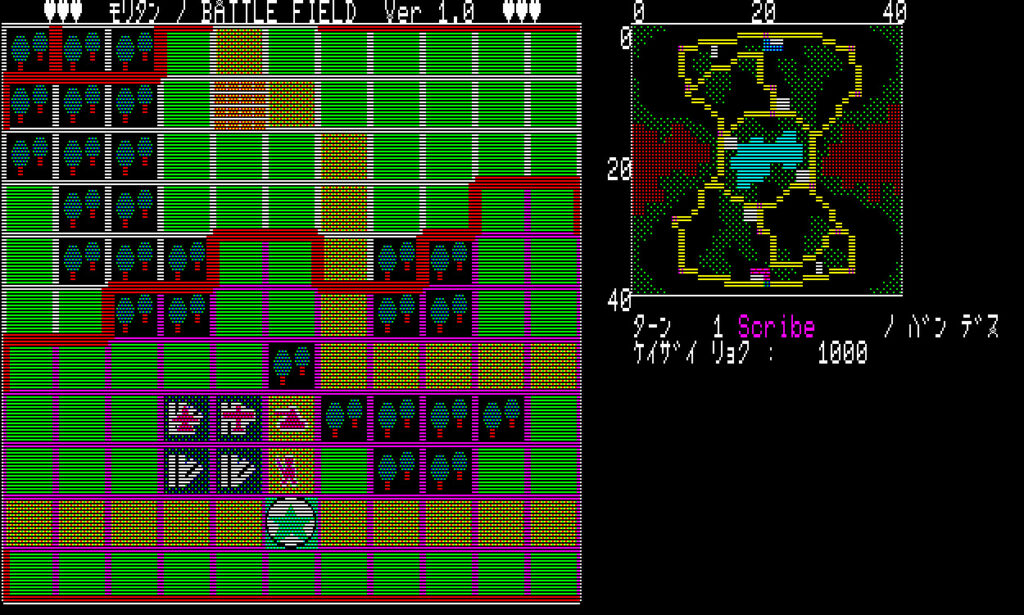
I also skip Koei’s Combat and Battle of Normandy that I mentioned earlier – I will only cover these games of lesser historical importance if I find both a manual and a translated version.
Finally, I also dropped the very minor Savo Island from my list for the time being as I could not find the documentation for it either ; it would have barely passed the BRIEF threshold anyway so I am not that sad about this. I am now toying with SSI’s Fighter Command, but that’s a major game so there may be a few games from the backlog before that one.
8 Comments
> Feel free to correct me in the comments, or I am bound to make a fool of myself in every game about Japan that I will cover.
well, my only exposition to the Sengoku period is Sengoku Rance, so I can’t say I’ll be of much help there
Not sure if it works in this version, but in the NES port of the second opus, you could take advantage of the fact that your peasants would never revolt the same turn they got angry enough to do so by jacking up your taxes to 100% and then just placating the now furious peasants with enough gold to make them okay with those rates for now. The rice and gold gains from doing this was astronomical.
There is no peasant revolt in this version. Apparently, there is still a trick with taxes where you switch taxes to 100% just before fall (the tax season) and then move to 0% immediately after that.
I am curious : how different is this game (or what I describe of it) from your experience with the NES version ?
Gameplay-wise it’s very similar, though there’s a few new additions like being able to marry another daimyo’s daughter for a much stronger alliance, being able bribe other daimyos’ peasants into moving into your territories, and the aforementioned peasant revolt mechanic. The biggest difference is, as you said, the ability to choose your daimyo, as well as the option to play the original central Japan map or a new entire-Japan map with a lot more territories and daimyos. Based on your description of the AI, it seems a bit smarter too, and is a lot more unwilling to attack units it can’t win against.
“A price of 1.1 in “gold” means that if I want to borrow one gold I will have to pay back 2.1 gold the following year”
Yeesh, talk about shark loans from the BoJ!
Since you’re not a gullible fool like me, learning the Japanese language, you might want to check out Ztranslate, a machine translation tool for games. Never used it myself, but apparently it works rather well, assuming you have the specs and a SSD. Granted, it won’t help without the manual. (there are also issues finding reviews for these games in old magazines, since we have a very incomplete picture of the period, owing to age and cost of them)
That said, while I haven’t played this, I have played one of Koei’s RPGs from this time, which shares its character creation with this game, simple, randomized numbers. I don’t quite think they were fully out of having everything play randomly at this point just yet, though this is at least better than the RPGs they did.
Very interesting to see this early version of the KOEI strategy stable.
Yes, I found the tactical battles a bit repetitive and uninteresting. But all those characters, wow! I can do without all the detailed ‘stats’ noise, the only point of note whether a character had the rarity of being truly exceptional or poor at something. But give a character a name (and later a face too), then I want to know exactly what they are all up to every turn.
The only Koei game I played is “Operation Europe: Path to Victory 1939-45”, and it’s really good (and available in English). I don’t know if you’ll play that one, but it’s from the 90s.